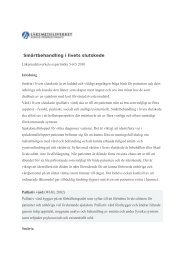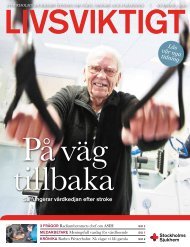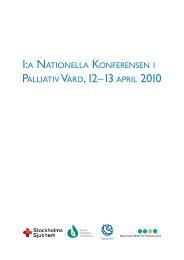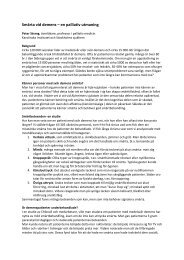Physiotherapy in palliative careâ - Stockholms sjukhem
Physiotherapy in palliative careâ - Stockholms sjukhem
Physiotherapy in palliative careâ - Stockholms sjukhem
Create successful ePaper yourself
Turn your PDF publications into a flip-book with our unique Google optimized e-Paper software.
problems <strong>in</strong>crease and the possibility to aid the patient with better symptom relief and a betterquality of life improve.Palliative care can be divided <strong>in</strong>to an early and a late phase. In the early phase the cancer hasspread but is respond<strong>in</strong>g to the tumor specific treatment. The goal is then quality of life and toprolong life. Patients may sometimes live several years with the disease, for example withbreast- or prostate cancer. In the late phase the tumor specific treatment has stopped and thisphase is often just a few weeks or sometimes months. The goal for this phase is quality of lifeand not life prolongation.(3) Also dur<strong>in</strong>g this phase radiation therapy can be given to relievepa<strong>in</strong>.Palliative care has its roots <strong>in</strong> the modern hospice movement <strong>in</strong>itiated by Dame CicelySaunders. She was an English nurse, social worker and later physician who <strong>in</strong> her work foundthat the patients did not just have physical pa<strong>in</strong> but also psychological, social and existentialproblems. She founded St Christopher’s hospice <strong>in</strong> London 1967. Apart from be<strong>in</strong>g the firsthospice it was also the first educational and research unit <strong>in</strong> this subject. The goal was toimprove the condition of life of the dy<strong>in</strong>g person and the family. Cicely Saunders work <strong>in</strong>spiredothers to follow and today there are followers throughout the world <strong>in</strong>clud<strong>in</strong>g Sweden.The quality of life of the patientWhen cure is unlikely the patient can get help to ma<strong>in</strong>ta<strong>in</strong> and if possible improve the quality oflife. The physiotherapist has an important role to complement <strong>palliative</strong> care treatment with avariation of symptom relief activities and thus keep<strong>in</strong>g/improv<strong>in</strong>g the patients bodily functions.When a person is seriously ill the awareness of how important the physical body is for allexperiences and emotions becomes obvious. The state of the body decides what the patient cantake part <strong>in</strong> and do <strong>in</strong> everyday life.The state of the patient can vary considerably from day to day. Patients tell how stressful it is tosee the body change and how the illness has made them more vulnerable as to how their body istreated and cared for by others.(4) To be touched on the body <strong>in</strong> an emphatic way can givesatisfaction and confirmation.When the illness progresses the physiotherapeutic contribution can still be important and thecontact with the patient is of course easier if there has been an earlier relation with the patient.Examples can be passive movements, massage and show<strong>in</strong>g positions of rest. Advice andsupport to families and personnel can be given.<strong>Physiotherapy</strong> <strong>in</strong> <strong>palliative</strong> care – a cl<strong>in</strong>ical handbook Ulla Frymark, Lilian Hallgren, Ann‐Charlotte Reisberg 8

















